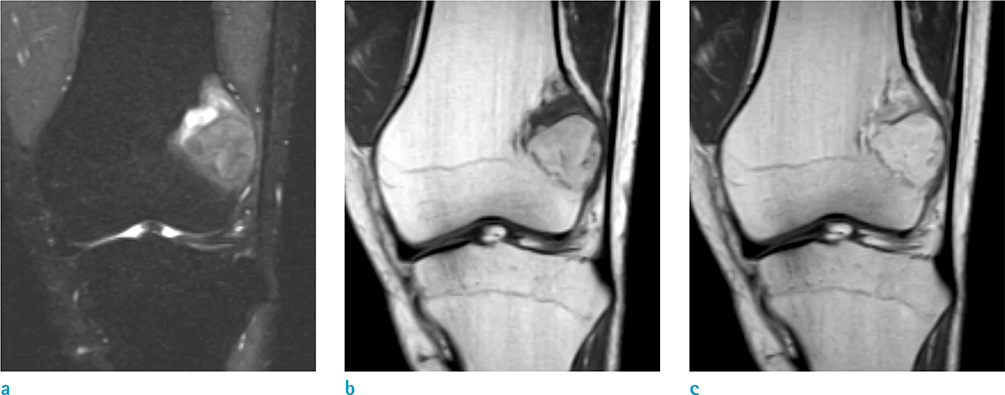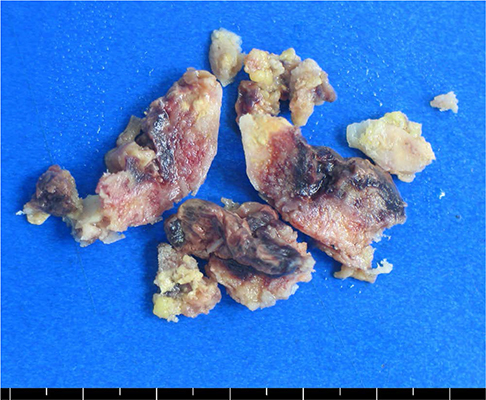Investig Magn Reson Imaging.
2016 Dec;20(4):264-268. 10.13104/imri.2016.20.4.264.
Benign Fibrous Histiocytoma with Cystic Change of the Femur: a Case Report
- Affiliations
-
- 1Department of Radiology, Konkuk University Medical Center, Konkuk University School of Medicine, Seoul, Korea. sgsgmoon@gmail.com
- KMID: 2366410
- DOI: http://doi.org/10.13104/imri.2016.20.4.264
Abstract
- Benign fibrous histiocytoma (BFH) is a rare benign primary skeletal tumor that occurs commonly in the long bones, spine and pelvis. BFH constitutes a diagnostic challenge because it shares clinical background, radiological characteristics, and histological features with other fibrous lesions such as non-ossifying fibroma, giant cell tumor. We present a case of BFH with cystic change that occurred in the distal femur. We did not identify any case of BFH with cystic change involving the majority of the lesion that occurred in the metaepiphysis of the long bone.
Figure
Reference
-
1. Grohs JG, Nicolakis M, Kainberger F, Lang S, Kotz R. Benign fibrous histiocytoma of bone: a report of ten cases and review of literature. Wien Klin Wochenschr. 2002; 114:56–63.2. Clarke BE, Xipell JM, Thomas DP. Benign fibrous histiocytoma of bone. Am J Surg Pathol. 1985; 9:806–815.3. Bertoni F, Calderoni P, Bacchini P, et al. Benign fibrous histiocytoma of bone. J Bone Joint Surg Am. 1986; 68:1225–1230.4. Matsuno T. Benign fibrous histiocytoma involving the ends of long bone. Skeletal Radiol. 1990; 19:561–566.5. Ceroni D, Dayer R, De Coulon G, Kaelin A. Benign fibrous histiocytoma of bone in a paediatric population: a report of 6 cases. Musculoskelet Surg. 2011; 95:107–114.6. Keskinbora M, Kose O, Karslioglu Y, Demiralp B, Basbozkurt M. Another cystic lesion in the calcaneus: benign fibrous histiocytoma of bone. J Am Podiatr Med Assoc. 2013; 103:141–144.7. Hamada T, Ito H, Araki Y, Fujii K, Inoue M, Ishida O. Benign fibrous histiocytoma of the femur: review of three cases. Skeletal Radiol. 1996; 25:25–29.8. Pattamparambath M, Sathyabhama S, Khatri R, Varma S, Narayanan NM. Benign fibrous histiocytoma of mandible: a case report and updated review. J Clin Diagn Res. 2016; 10:ZD24–ZD26.9. Murphey MD, Nomikos GC, Flemming DJ, Gannon FH, Temple HT, Kransdorf MJ. From the archives of AFIP. Imaging of giant cell tumor and giant cell reparative granuloma of bone: radiologic-pathologic correlation. Radiographics. 2001; 21:1283–1309.10. O'Donnell P, Saifuddin A. The prevalence and diagnostic significance of fluid-fluid levels in focal lesions of bone. Skeletal Radiol. 2004; 33:330–336.
- Full Text Links
- Actions
-
Cited
- CITED
-
- Close
- Share
- Similar articles
-
- A Case of Deep Aneurysmal Benign Fibrous Histiocytoma with Atypical Clinical Features
- Deep Benign Fibrous Histiocytoma Showing Multiple Metastases
- Comments to "Deep Benign Fibrous Histiocytoma Showing Multiple Metastases"
- A Case of Subcutaneous Benign Fibrous Histiocytoma
- A Case of Aneurysmal Benign Fibrous Histiocytoma





